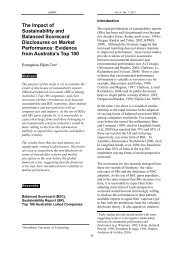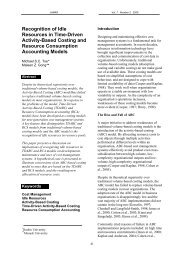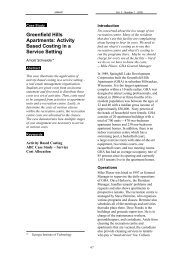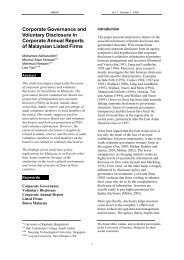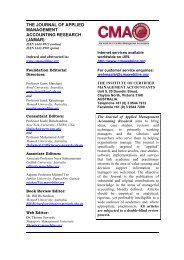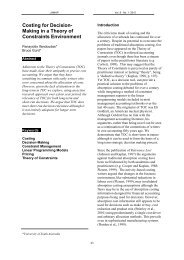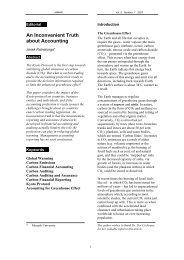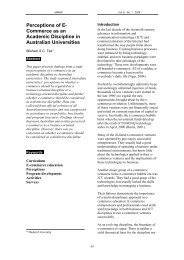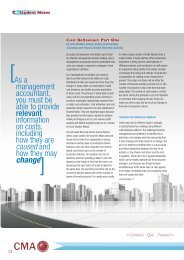Investigating the Determinants of Perceived Procedural Fairness in ...
Investigating the Determinants of Perceived Procedural Fairness in ...
Investigating the Determinants of Perceived Procedural Fairness in ...
- No tags were found...
You also want an ePaper? Increase the reach of your titles
YUMPU automatically turns print PDFs into web optimized ePapers that Google loves.
JAMAR Vol. 11 · No. 1 2013opportunity to engage <strong>in</strong> sett<strong>in</strong>g goals. It is<strong>the</strong>refore reasonable to propose thatparticipation is positively associated withprocedural fairness. Additionally, L<strong>in</strong>d andTyler (1988, p. 236) argue that “<strong>the</strong>opportunity to exercise voice (participation)constitutes a visible marker <strong>of</strong> groupmembership … mute procedures are seen as… unjust because <strong>the</strong>y appear to deny fullmembership rights to those denied voice”(paren<strong>the</strong>ses added) and “…one <strong>of</strong> <strong>the</strong> mostpotent determ<strong>in</strong>ants <strong>of</strong> <strong>the</strong> procedural fairness<strong>of</strong> a social decision-mak<strong>in</strong>g procedure is <strong>the</strong>extent to which those affected by <strong>the</strong> decisionare allowed to participate <strong>in</strong> <strong>the</strong> decisionmak<strong>in</strong>gprocess through <strong>the</strong> exercise <strong>of</strong>process control or voice” (p. 176). Similarly,Early and Kanfer (1985) argue that s<strong>in</strong>ceparticipation gives opportunity for <strong>in</strong>put, itprovides <strong>the</strong> <strong>in</strong>dividual with perceived masteryor control over a situation; thus participationmay enhance perceived fairness.In a budget<strong>in</strong>g context, Wentzel (2002) studied88 cost centre managers <strong>of</strong> a downsizedhospital <strong>in</strong> <strong>the</strong> US and found that budgetparticipation is positively associated withprocedural fairness. Similar results were foundby Lau and Tan (2006) among managers <strong>of</strong>manufactur<strong>in</strong>g companies <strong>in</strong> S<strong>in</strong>gapore. Thisstudy <strong>the</strong>refore argues that a positiveassociation holds between participation <strong>in</strong>sett<strong>in</strong>g targets and procedural fairness.Ha1: Participation <strong>in</strong> target sett<strong>in</strong>g ispositively associated with procedural fairness.Goal-Atta<strong>in</strong>ment-Reward L<strong>in</strong>k and<strong>Procedural</strong> <strong>Fairness</strong>The management control systems literaturesuggests that <strong>the</strong> performance evaluation andreward system is an important component <strong>of</strong><strong>the</strong> management control system designed tomotivate organisational members to performbetter and <strong>in</strong> accordance with <strong>the</strong>organisation’s objectives (Otley, 1999;Merchant and Van der Stede, 2003).Accord<strong>in</strong>g to Emmanuel et al. (1990) andMerchant and Van der Stede (2003), one <strong>of</strong> <strong>the</strong>pr<strong>in</strong>cipal means <strong>of</strong> motivat<strong>in</strong>g subord<strong>in</strong>atestowards effective performance is to l<strong>in</strong>korganisational rewards to <strong>the</strong> level <strong>of</strong>performance achieved. This implies that <strong>the</strong>l<strong>in</strong>k between <strong>the</strong> achievement <strong>of</strong> goals orperformance targets set and rewards should betransparent. A recent empirical study byKom<strong>in</strong>is and Emmanuel (2007), us<strong>in</strong>g asample <strong>of</strong> middle managers <strong>in</strong> a large UKbasedf<strong>in</strong>ancial <strong>in</strong>stitution, found that <strong>the</strong>effect <strong>of</strong> transparency <strong>in</strong> <strong>the</strong> performancerewardl<strong>in</strong>k on motivation is <strong>in</strong>direct via <strong>the</strong>value <strong>of</strong> extr<strong>in</strong>sic rewards. In o<strong>the</strong>r words,Kom<strong>in</strong>is and Emmanuel’s (2007) studysuggests that <strong>the</strong> effect <strong>of</strong> transparency <strong>of</strong> <strong>the</strong>performance-reward l<strong>in</strong>k on motivation maybe mediated by o<strong>the</strong>r variables, and <strong>in</strong> <strong>the</strong>irstudy this was <strong>the</strong> value <strong>of</strong> extr<strong>in</strong>sic rewards.Draw<strong>in</strong>g on Emmanuel et al.’s (1990) andMerchant and Van der Stede’s (2003)contentions and extend<strong>in</strong>g Kom<strong>in</strong>is andEmmanuel’s (2007) f<strong>in</strong>d<strong>in</strong>gs, this study arguesthat <strong>the</strong> transparency <strong>of</strong> <strong>the</strong> goal-atta<strong>in</strong>mentrewardl<strong>in</strong>k is likely to enhance motivation viaperceived procedural fairness. This is becausea transparent rewards system should beconsistent, unbiased, and accurate, all <strong>of</strong> whichare characteristics <strong>of</strong> procedural fairness(Leventhal, 1980). Therefore, this studyhypo<strong>the</strong>sises that transparency <strong>of</strong> <strong>the</strong> goalatta<strong>in</strong>ment-rewardl<strong>in</strong>k will be positivelyassociated with procedural fairness.Ha2: Transparency <strong>of</strong> <strong>the</strong> goal-atta<strong>in</strong>mentrewardl<strong>in</strong>k will be positively associated withprocedural fairness.Goal Specificity and <strong>Procedural</strong> <strong>Fairness</strong>Goal specificity refers to “<strong>the</strong> extent to which<strong>the</strong> goals are clearly def<strong>in</strong>ed by a supervisor”(Fang et al., 2005). In <strong>the</strong> context <strong>of</strong>performance measurement, evaluation andreward systems <strong>the</strong> goals can be f<strong>in</strong>ancial ornonf<strong>in</strong>ancial. Organisations which develop andadopt specific performance measures, whe<strong>the</strong>rf<strong>in</strong>ancial or nonf<strong>in</strong>ancial, for performanceevaluation are more likely to develop specificgoals and targets for employees to pursue,than are organisations which have no specificperformance measures for performanceevaluation. Fur<strong>the</strong>r, <strong>the</strong> existence <strong>of</strong> prespecifiedgoals is likely to provide clearerunderstand<strong>in</strong>g (goal clarity) for organisationalmembers and <strong>in</strong>dicate how <strong>the</strong>y will beevaluated. In addition, goal specificity andclarity <strong>in</strong>forms employees <strong>of</strong> <strong>the</strong>irresponsibilities and performance targets. Ino<strong>the</strong>r words, <strong>the</strong> existence <strong>of</strong> specific goalswill guide employees <strong>in</strong> decid<strong>in</strong>g where <strong>the</strong>yshould direct <strong>the</strong>ir attention and effort.32




